Transform Call Centers with AI Automation Steps
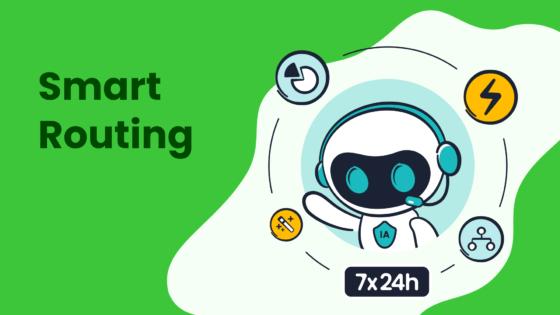
AI is transforming the landscape of call center operations. By leveraging automation, businesses can streamline repetitive tasks, enhancing efficiency and prioritizing exceptional customer experiences. Companies utilizing AI report a 37% reduction in first response times and resolve tickets 52% faster. With the integration of chatbots, staffing needs during peak seasons can be reduced by up to 68%, leading to a 35% decrease in costs and a 32% increase in revenue.
In today’s competitive environment, automation is essential for operational success. It significantly boosts customer satisfaction and retention, with AI integration increasing Customer Satisfaction (CSAT) scores by 27% and retention rates by 25%. AI-based call center solutions, such as those offered by Sobot, enable businesses to achieve these impressive outcomes. Sobot’s cutting-edge tools, including its Voice/Call Center, optimize communication and elevate customer interactions. This ensures businesses can efficiently manage high volumes of inquiries while maintaining exceptional service quality.
Benefits of AI-Based Call Center Automation

Enhanced efficiency and reduced operational costs
AI transforms call center operations by automating repetitive tasks and optimizing workflows. You can achieve significant savings by reducing reliance on human agents for routine inquiries. AI-driven voice automation, for example, cuts voice support costs by up to 50%. Many call centers report a 30-50% reduction in operational costs within the first year of implementation.
A financial services company experienced remarkable results after deploying AI-powered virtual agents. Their operational costs dropped by 40%, while customer satisfaction increased by 25%. These savings allow you to reinvest in improving customer experience and scaling operations. Sobot’s Voice/Call Center solution enhances efficiency with features like intelligent IVR and bulk outbound tasks, ensuring streamlined communication and reduced costs.
Improved customer satisfaction with faster response times
AI enables faster response times, which directly impact customer satisfaction. Shorter first response times (FRT) reflect excellent support and improve the overall customer experience. AI call centers leverage data-driven insights to deliver accurate and timely responses, boosting satisfaction scores.
| Metric | Description |
|---|---|
| Response Time | Faster response times boost efficiency and significantly enhance customer satisfaction. |
| First Response Time | A shorter FRT indicates excellent support, leading to improved customer satisfaction. |
| Customer Satisfaction Score (CSAT) | Measures customer happiness through post-interaction surveys, improved by AI insights. |
Sobot’s AI-powered solutions, such as its Voice/Call Center, integrate real-time call monitoring and transcription to ensure high-quality interactions. These tools help you reduce average handle times and increase first-contact resolution rates, driving better customer satisfaction.
24/7 availability and scalability for global operations
AI-based call centers operate around the clock, ensuring your customers receive support whenever they need it. This 24/7 availability is crucial for businesses with global operations. AI systems scale effortlessly to handle high volumes of inquiries, even during peak seasons.
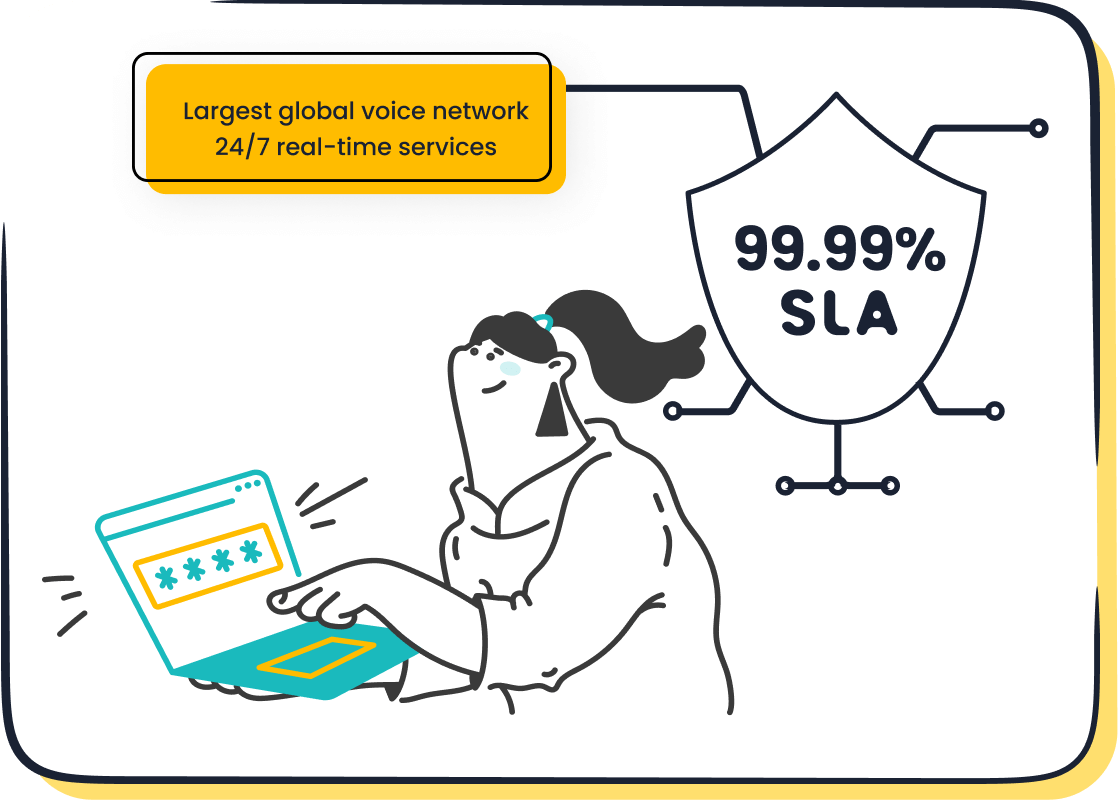
Sobot’s Voice/Call Center offers global number availability and time zone support, enabling seamless communication across borders. Its AI-powered voicebots provide intelligent interaction and intent recognition, ensuring consistent service quality. With a system uptime of 99.99%, Sobot guarantees reliable operations, helping you meet customer expectations worldwide.
Reduced human error and increased accuracy
AI significantly reduces human error in call center operations, ensuring higher accuracy and better outcomes. Unlike humans, AI systems process large datasets without fatigue, identifying patterns and trends that might go unnoticed. For example:
- AI automates repetitive tasks like data entry, ensuring consistent and error-free records.
- In customer service, AI chatbots handle common queries with precision, providing quick and accurate responses.
- AI-powered tools monitor transactions in real-time, detecting anomalies and enhancing security.
Sobot’s Voice/Call Center solution exemplifies this. Its intelligent IVR and AI-powered voicebots streamline workflows, reducing the chances of misrouted calls or incorrect responses. These tools ensure your customers receive accurate information, improving their overall experience.
By minimizing errors, AI not only enhances service quality but also builds trust. Customers value reliability, and accurate interactions foster loyalty. This accuracy also translates into reduced operational costs, as fewer mistakes mean less time and resources spent on corrections.
Data-driven insights for better decision-making
AI empowers call centers with actionable, data-driven insights, enabling smarter decisions. Advanced analytics sift through vast amounts of customer interactions, uncovering trends and recurring issues. These insights help you identify customer sentiments, areas for improvement, and opportunities to enhance the customer experience.
For instance:
- AI forecasts future trends by analyzing historical data, helping you plan effectively.
- Real-time analytics highlight customer pain points, allowing you to address them proactively.
- Visualized data simplifies complex information, making it easier to strategize and improve service quality.

Sobot’s Voice/Call Center offers robust monitoring and analysis features. It tracks call data, providing detailed insights into performance metrics. This helps you optimize operations, improve agent training, and refine customer interactions. With these tools, you can make informed decisions that drive efficiency and elevate service standards.
AI call centers thrive on these insights, ensuring they adapt to evolving customer needs. By leveraging AI-driven solutions, you can stay ahead of the competition and deliver exceptional service consistently.
Steps to Automate Call Center Operations with AI
Assessing current operations and identifying inefficiencies
Before implementing AI in your call center, you need to evaluate your current operations. This step helps you pinpoint inefficiencies and areas where automation can make the most impact. High call volumes often lead to longer wait times, frustrating customers and reducing satisfaction. Inconsistent service quality further affects customer loyalty, while the growing demand for personalized customer interactions highlights the need for smarter solutions.
Tip: Create a detailed report of your call center’s performance metrics, including average handle time (AHT), first-call resolution (FCR), and customer satisfaction scores (CSAT). These metrics reveal gaps in efficiency and service quality.
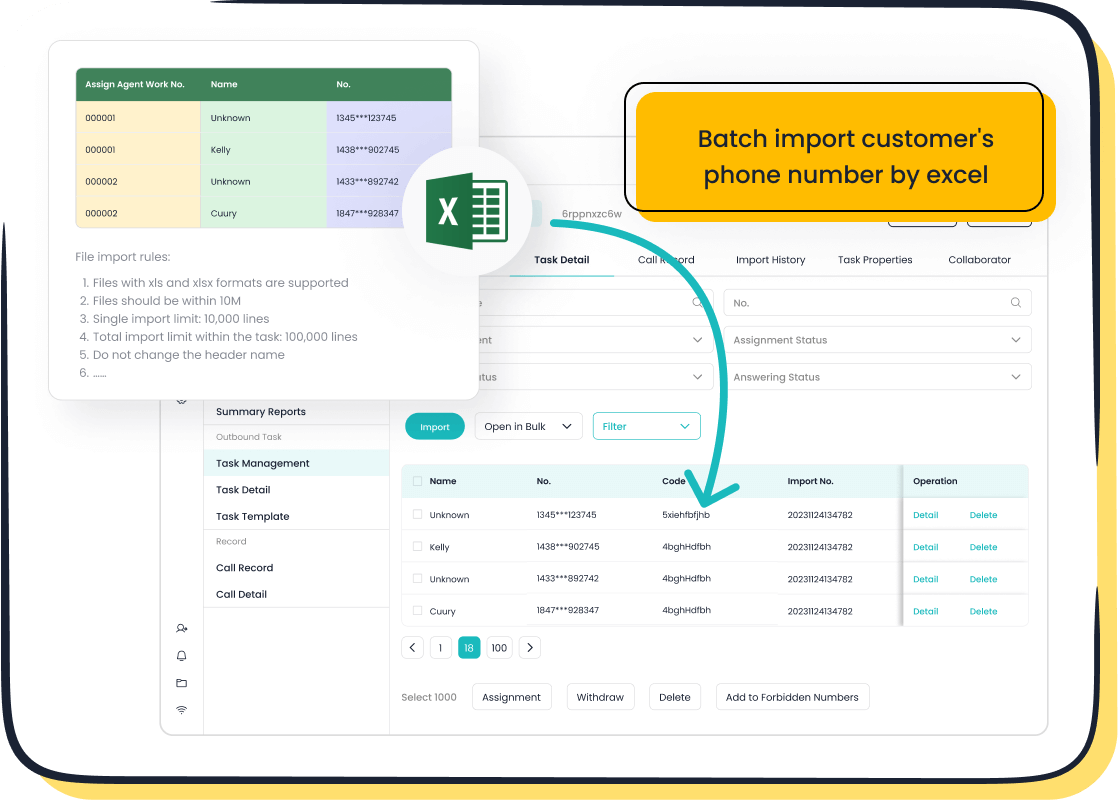
Automation streamlines operations by handling repetitive tasks, freeing agents to focus on complex issues. AI-powered call center solutions, like Sobot Voice/Call Center, offer tools to analyze call data and identify recurring problems. For example, Sobot’s real-time monitoring and analysis features help you uncover inefficiencies and improve operational efficiency.
Selecting the right AI tools, such as Sobot Voice/Call Center
Choosing the right AI tools is critical for successful call center automation. You should evaluate tools based on their ability to enhance service quality, improve efficiency, and meet your business needs. Metrics like FCR, AHT, and CSAT provide valuable insights into the effectiveness of AI solutions.
| Metric | Description |
|---|---|
| First-Call Resolution (FCR) | Top call centers achieve rates above 80%, reflecting effective issue resolution and customer satisfaction. |
| Average Handle Time (AHT) | Lower AHT indicates streamlined processes and improved efficiency. |
| Customer Satisfaction Scores (CSAT) | Scores around 85% show strong performance in resolving issues and fostering loyalty. |
| AI Impact on Agent Productivity | AI tools reduce AHT and guide agents through resolution paths, boosting efficiency. |
| Reduction in Wait Times | AI adoption leads to a 25% decrease in wait times, improving customer service speed. |
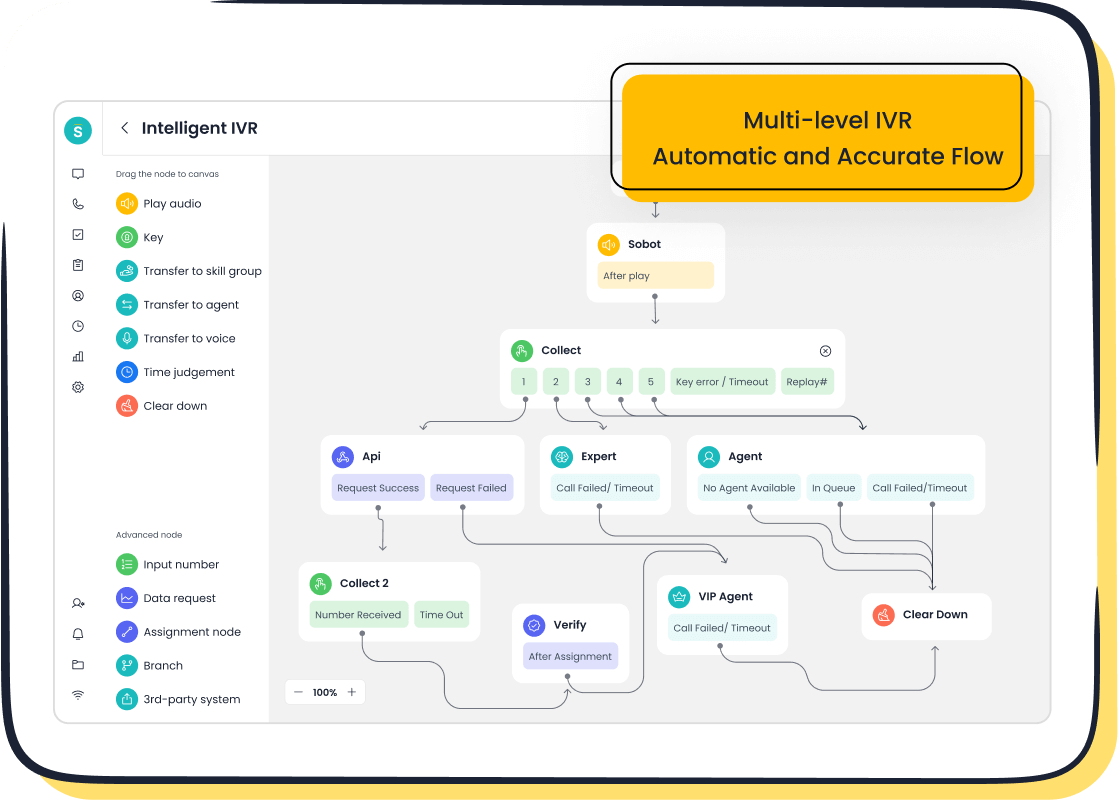
Sobot Voice/Call Center excels in these areas. Its intelligent IVR system routes calls efficiently, while AI-powered voicebots handle repetitive tasks with accuracy. Features like global number availability and time zone support ensure seamless communication across borders. With a system uptime of 99.99%, Sobot guarantees reliable operations, enhancing customer experience and service quality.
Training agents to work effectively with AI systems
Integrating AI into your call center requires proper training for your agents. Start by identifying gaps in their knowledge and areas where they struggle to meet performance metrics. Collect feedback from employees about their training experiences to ensure the program addresses their needs.
| Best Practice | Description |
|---|---|
| Assessing current training challenges | Identify gaps in knowledge and collect feedback from agents to improve training programs. |
| Aligning AI tools with specific training goals | Customize AI tools to meet the unique demands of your call center’s operations. |
| Continuous feedback and adjustments | Use AI to provide ongoing feedback, ensuring training remains effective and relevant. |
Sobot Voice/Call Center simplifies this process with its unified workspace and AI copilots. These tools assist agents by generating responses and summaries during interactions, reducing their workload and improving accuracy. Real-time coaching features guide agents through complex customer concerns, ensuring they adapt quickly to AI systems.
By investing in training, you empower your team to leverage AI effectively, enhancing customer satisfaction and operational efficiency. Well-trained agents combined with AI-driven solutions create a call center that delivers exceptional service consistently.
Integrating AI solutions with existing call center infrastructure

Integrating AI solutions into your existing call center infrastructure requires a strategic approach to ensure seamless operations. Start by evaluating your current systems and identifying areas where AI can enhance efficiency. Compatibility is key. AI tools must integrate smoothly with your CRM, ticketing systems, and communication platforms. For example, Sobot’s Voice/Call Center offers seamless integration with existing systems, enabling you to unify customer data and streamline workflows.
Successful integration often involves gradual implementation. Twilio’s solutions demonstrate how businesses can adopt AI incrementally, minimizing disruptions. Similarly, Google Cloud’s Contact Center AI showcases how advanced tools can enhance call center operations without overhauling existing systems. Companies like Upcore have achieved scalability and adaptability by integrating AI-powered solutions into their call centers.
Real-world results highlight the benefits of integration. A telecommunications company reported a 30% increase in customer satisfaction after implementing AI. An e-commerce business saw a 20% rise in customer retention, while a global bank experienced a 25% boost in satisfaction rates. These examples underscore the transformative potential of AI in call center automation.
Tip: Collaborate with your IT team to ensure a smooth transition. Test integrations in a controlled environment before full deployment to avoid disruptions.
Testing, refining, and optimizing AI implementations
Testing and refining AI implementations are critical for achieving optimal performance. Begin by conducting pilot tests to evaluate the effectiveness of AI tools in real-world scenarios. Monitor key metrics such as Average Handle Time (AHT), First-Call Resolution (FCR), and customer satisfaction scores to identify areas for improvement.
Performance testing often reveals significant gains. For instance:
- OpenQuestion by Teneo.ai reduced misrouted calls by 30% and decreased AHT by 2 minutes.
- Call containment rates averaged 60%, leading to substantial time savings.
- NLU accuracy improved to 95-100%, enhancing customer interactions.

Refinement involves analyzing feedback and making adjustments. AI tools like Sobot’s Voice/Call Center provide real-time monitoring and analytics, enabling you to fine-tune operations. Immediate results include reduced agent transfer rates and improved call quality.
Note: Continuous optimization ensures your AI systems adapt to evolving customer needs. Regular updates and training sessions keep your team aligned with the latest advancements.
Scaling AI solutions for long-term success
Scaling AI solutions requires a focus on long-term goals and performance indicators. Define clear metrics that align with your strategic objectives. For example, businesses leveraging AI often track KPIs such as customer satisfaction, operational efficiency, and cost savings.
| Metric | Description |
|---|---|
| Customer Satisfaction | Measures the impact of AI on customer experience and loyalty. |
| Operational Efficiency | Tracks improvements in workflows and resource utilization. |
| Cost Savings | Evaluates the financial benefits of automation and reduced reliance on manual tasks. |
Sobot’s AI-powered call center solutions offer scalability with features like global number availability and intelligent IVR. These tools ensure consistent service quality as your operations expand. Companies using AI for quality assurance evaluate every call for compliance, showcasing the scalability of AI in maintaining high standards.
Long-term success also depends on adaptability. AI call centers thrive by analyzing extensive data and refining procedures. By setting clear goals and leveraging advanced analytics, you can enhance customer experience and stay ahead of the competition.
Tip: Regularly review your AI systems to ensure they align with your business objectives. Scaling should focus on delivering consistent value to your customers while optimizing operational efficiency.
Key Features of AI Solutions for Call Centers
Natural language processing (NLP) for understanding customer queries
Natural language processing (NLP) enhances how call centers interpret and respond to customer inquiries. By analyzing language patterns, NLP enables AI systems to understand context, intent, and sentiment. This leads to more accurate and personalized responses. For example, sentiment analysis helps track customer attitudes, while dependency parsing improves the interpretation of complex queries.
| NLP Technique | Application in Customer Service |
|---|---|
| Sentiment Analysis | Tracking customer reviews and social media posts to proactively address complaints. |
| Dependency Parsing | Understanding the structure of customer queries for better interpretation. |
| Word Embedding | Enhancing the understanding of customer intent through contextual word meanings. |
| Machine Translation | Eliminating linguistic barriers to provide answers in multiple languages. |
| Topic Modeling | Identifying key themes in customer inquiries to improve response accuracy. |
| Text Summarization | Condensing information to provide quick and relevant answers to customer queries. |
NLP-based chatbots and voice assistants, like those in Sobot’s Voice/Call Center, streamline operations by providing precise answers. They reduce response times and improve customer satisfaction by understanding the nuances of human language.
Multilingual support for diverse customer bases
AI-powered call centers excel in serving global audiences by offering multilingual support. This feature ensures customers receive assistance in their preferred language, enhancing satisfaction and loyalty. Metrics like First Call Resolution (FCR) rates measure the success of multilingual strategies. Collecting and analyzing these metrics helps refine approaches and improve service quality.
Sobot’s Voice/Call Center supports global communication with features like machine translation and time zone adaptability. These tools eliminate language barriers and ensure seamless interactions across borders. For example, a business using multilingual AI solutions can achieve higher FCR rates and better customer retention.
Tip: Regularly assess language proficiency and customer feedback to optimize multilingual capabilities.
AI-powered voicebots and chatbots for seamless interactions
AI-powered voicebots and chatbots revolutionize call center automation by handling repetitive tasks efficiently. These tools operate 24/7, managing multiple calls simultaneously. Studies show that AI-assisted teams save 45% of the time spent on calls and resolve issues 44% faster. A telecom company reported a 35% reduction in call handling time after implementing voice AI.
Sobot’s AI-powered voicebots enhance efficiency by automating routine inquiries and routing complex issues to agents. This reduces operational costs by up to 30% while maintaining high service quality. Customers benefit from faster resolutions and consistent support, even during peak hours.
Note: AI voicebots not only improve efficiency but also free up agents to focus on more complex customer needs.
Predictive analytics for proactive customer service
Predictive analytics transforms how you deliver customer service by anticipating issues before they arise. This AI-powered capability uses historical data and real-time insights to forecast trends, enabling you to take proactive measures. For example, during festive sales, predictive analytics can identify potential spikes in ticket volumes, allowing you to allocate resources effectively. It also highlights customer segments at risk of subscription cancellations, giving you the opportunity to engage them before they churn.
Customers appreciate proactive communication. Studies show that 87% of customers prefer companies that reach out to address potential concerns. Predictive analytics empowers your call center to meet this expectation by streamlining operations and enhancing service delivery. AI systems continuously improve decision-making by integrating big data from various sources, offering a deeper understanding of customer behavior.
Imagine a utility company using weather data to predict service disruptions. By informing customers in advance, they not only reduce complaints but also build trust. Similarly, your call center can leverage predictive analytics to enhance agent productivity and personalize customer experiences. Sobot’s AI-driven solutions excel in this area, offering tools that analyze call data and provide actionable insights. These features ensure your team stays ahead of customer needs, delivering exceptional service consistently.
Tip: Use predictive analytics to identify recurring issues and address them proactively. This approach not only improves customer satisfaction but also reduces operational costs.
Real-time call monitoring and transcription with Sobot Voice/Call Center
Real-time call monitoring and transcription redefine how you manage call center operations. These AI-driven tools provide instant insights into customer interactions, helping you maintain high service quality. With real-time monitoring, you can track ongoing calls, identify issues, and offer immediate support to agents. This ensures that every customer receives accurate and timely assistance.
Transcription features capture conversations word-for-word, creating a valuable resource for training and analysis. By reviewing transcripts, you can identify patterns, improve agent performance, and refine your call center’s workflows. For example, analyzing transcripts can reveal common customer pain points, enabling you to address them more effectively.
Sobot’s Voice/Call Center takes these capabilities to the next level. Its real-time monitoring tools allow you to oversee call quality and agent performance seamlessly. The transcription feature not only records calls but also integrates with analytics tools to provide actionable insights. With a system uptime of 99.99%, Sobot ensures reliable operations, making it easier for you to deliver consistent, high-quality service.
Note: Real-time monitoring and transcription are essential for maintaining compliance and improving customer satisfaction. Use these tools to stay ahead in today’s competitive landscape.
Challenges and Solutions in AI-Based Call Center Automation
Overcoming integration challenges with legacy systems
Integrating AI into legacy call center systems can be complex. Older infrastructures often lack compatibility with modern AI functionalities, making seamless integration difficult. Limited scalability and processing power further hinder real-time analytics and large-scale automation. Upgrading these systems can also be costly and time-consuming, especially for businesses with tight budgets.
| Challenge | Description |
|---|---|
| Legacy System Compatibility | Existing infrastructures may struggle to support AI functionalities, requiring careful planning. |
| Limited Scalability | Legacy systems often lack the processing power needed for real-time analytics and large-scale automation. |
| High Costs of Upgrading | Upgrading can be expensive and time-consuming, posing a barrier for organizations with limited resources. |
| Resistance to Change | Employees may resist new processes and workflows, complicating the integration of AI. |
To address these challenges, you should evaluate your current infrastructure and identify areas where AI can add value. Sobot’s Voice/Call Center offers seamless integration with existing systems, enabling you to unify customer data and streamline workflows. Gradual implementation and pilot testing can minimize disruptions, ensuring a smooth transition to AI-powered solutions.
Addressing employee resistance to AI adoption
Employees often resist AI adoption due to fear of job loss or uncertainty about new technologies. Clear communication about the benefits of AI can reduce this resistance. Engaging employees in the adoption process and empowering them with training ensures they feel confident using AI tools.
- Communication and Transparency: Explain how AI enhances their roles rather than replacing them.
- Involvement and Empowerment: Involve employees in decision-making to build trust.
- Support and Training: Provide comprehensive training to help them adapt to AI systems.
- Addressing Layoff Anxiety: Reassure employees that AI will reduce repetitive tasks, allowing them to focus on complex issues.
- Leveraging Employee Feedback: Collect feedback to refine AI implementations and improve acceptance.

Sobot’s Voice/Call Center simplifies this transition with tools like AI copilots, which assist agents during interactions. These copilots reduce workloads and improve accuracy, helping employees see AI as a valuable ally rather than a threat.
Ensuring data security and compliance with regulations
Data security is critical when implementing AI in call centers. Customers trust you to protect their sensitive information. Compliance with regulations like GDPR and CCPA ensures you meet legal standards while safeguarding customer data.
| Key Area | Description |
|---|---|
| Data Security Measures | Implement stringent security protocols to protect customer information. Regular audits can identify potential vulnerabilities. |
| Training Programs | Regularly train employees on compliance standards and best practices to ensure they are well-informed. |
| Monitoring and Reporting | Establish systems for continuous monitoring of compliance metrics and generate reports to track adherence over time. |
Strong encryption protocols and regular audits are essential for maintaining security. Sobot’s Voice/Call Center ensures encrypted data transfer and dialing, providing a secure platform for customer interactions. By adhering to these measures, you can build trust and maintain compliance with industry standards.
Managing costs and achieving ROI expectations
Effective cost management is crucial for achieving a strong return on investment (ROI) in call center operations. AI-powered automation helps you identify inefficiencies and streamline processes, leading to significant savings. For example, AI tools can reduce operational costs by automating repetitive tasks, such as data entry and call routing. This allows your team to focus on more strategic activities, improving overall productivity.
AI also enhances financial forecasting. By analyzing historical data, it provides accurate predictions, enabling better resource allocation. Predictive analytics ensures you allocate budgets effectively, avoiding unnecessary expenses. Additionally, real-time insights allow you to adapt quickly to market changes, ensuring your call center remains agile and cost-efficient.
| Benefit | Description |
|---|---|
| Cost-saving opportunities | AI tools identify areas where costs can be reduced, enhancing overall financial performance. |
| Improved forecasting accuracy | Leveraging historical data and predictive analytics leads to more reliable financial forecasts. |
| Enhanced resource allocation | AI enables better allocation of resources, reducing operational costs while improving service. |
| Real-time insights | Provides immediate data that helps in adapting strategies to market changes quickly. |
| Streamlined financial processes | Automates repetitive tasks, allowing teams to focus on strategic decision-making. |
| Optimized cash flow management | Improves cash flow forecasting and management, contributing to better financial health. |
Sobot’s Voice/Call Center exemplifies these benefits. Its intelligent IVR and AI-powered voicebots automate workflows, reducing costs while maintaining high service quality. With features like real-time monitoring and global number availability, Sobot ensures your call center operates efficiently, delivering measurable ROI.
Tip: Regularly review your financial metrics, such as cost per call and ROI, to ensure your AI solutions align with your business goals.
Continuous monitoring and optimization of AI systems
Continuous monitoring is essential to maintain the performance of AI systems in your call center. Real-time analysis of calls provides immediate feedback, allowing you to adjust strategies on the fly. For instance, sentiment analysis helps you understand customer emotions during interactions, enabling more empathetic responses.
Predictive analytics plays a key role in anticipating customer needs. By analyzing trends, it helps you prepare for potential issues, such as increased call volumes during peak seasons. AI-driven performance management tools also streamline operations, improving agent efficiency and ensuring consistent service quality.
- Real-time analysis of calls enhances immediate feedback and performance adjustments.
- Sentiment analysis helps in understanding customer emotions during interactions.
- Predictive analytics allows call centers to anticipate customer needs based on trends.
- AI-driven performance management tools streamline operations and improve agent efficiency.
Sobot’s Voice/Call Center offers robust monitoring features, including real-time call tracking and transcription. These tools provide actionable insights, helping you refine workflows and improve customer satisfaction. With a system uptime of 99.99%, Sobot ensures your AI systems remain reliable and effective.
Note: Regular updates and training sessions keep your team aligned with the latest advancements, ensuring your call center stays ahead of customer expectations.
Future Trends in AI for Call Centers

The rise of conversational AI and voice recognition
Conversational AI and voice recognition are reshaping call center operations. These technologies enable systems to understand customer intent, respond intelligently, and even detect emotions. By 2025, over 75% of customer service operations will integrate conversational AI into their engagement channels, according to Gartner. Multimodal AI systems, which combine voice and text, achieve up to 30% higher accuracy in understanding user intent compared to single-mode systems.
Voice recognition is also gaining traction as the number of voice assistant devices worldwide is projected to reach 8.4 billion by 2025. Emotionally intelligent AI can increase customer satisfaction rates by up to 40%, while conversational AI voice bots resolve up to 70% of queries instantly. These advancements reduce wait times and improve customer experiences.
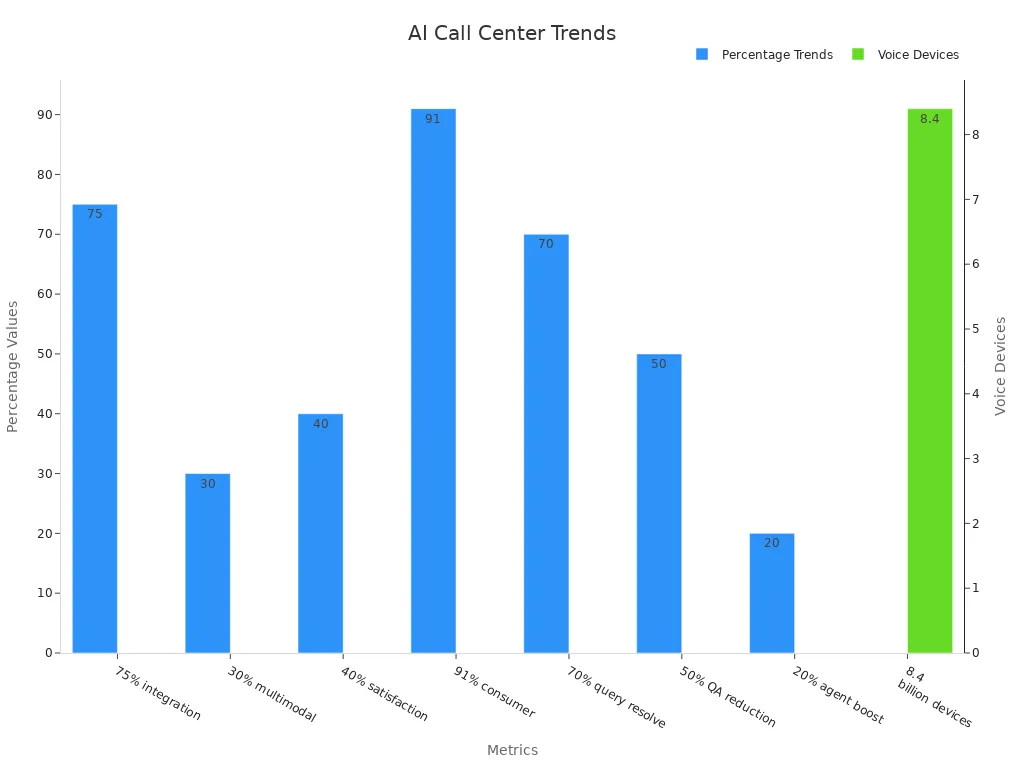
Sobot’s Voice/Call Center leverages conversational AI to enhance customer interactions. Its AI-powered voicebots provide intelligent responses, reducing operational costs and improving service quality. These tools ensure your call center stays ahead in delivering seamless, efficient communication.
Hyper-personalization through advanced data analytics
Hyper-personalization transforms how you engage with customers. Advanced data analytics allow call centers to tailor interactions based on individual preferences, creating a sense of exclusivity. This approach boosts customer satisfaction and loyalty. For example, Netflix reports that over 80% of content viewed comes from personalized recommendations, showcasing the power of data-driven personalization.
Hyper-personalization also increases conversion rates and retention. Customers feel valued when their needs are anticipated, encouraging repeat purchases. Sobot’s AI solutions excel in this area by analyzing call data to provide actionable insights. These insights help you deliver personalized experiences that enhance customer engagement and drive business growth.
AI-driven workforce management and scheduling
AI-driven workforce management optimizes call center operations by analyzing historical data and predicting call volumes. This ensures the right number of agents are scheduled, reducing idle time and overstaffing. AI tools dynamically adjust schedules based on agent availability and unexpected demand surges, ensuring fair workload distribution.
- AI tracks agent activities in real time, categorizing strengths and areas for improvement.
- Improved scheduling leads to better employee satisfaction and lower attrition.
- AI assigns tasks based on agent expertise, improving first-call resolution rates.
A Gartner report highlights that automated workforce scheduling reduces errors by 40% and improves productivity by 25%. Sobot’s Voice/Call Center integrates AI-driven scheduling systems to create optimal work schedules. These tools enhance efficiency, ensuring your call center operates smoothly while maintaining high employee satisfaction.
Omnichannel support powered by AI
Omnichannel support powered by AI transforms how you manage customer interactions. It ensures seamless communication across multiple platforms, including voice, email, chat, and social media. This approach allows customers to switch between channels without repeating their concerns, creating a unified and satisfying experience.
AI-driven omnichannel solutions improve customer engagement by personalizing interactions. For example, AI analyzes customer data to tailor responses, enhancing satisfaction and loyalty. Additionally, automation streamlines workflows, enabling your call center to handle high volumes of inquiries efficiently. By automating routine tasks, AI reduces operational costs and frees agents to focus on complex issues.
| Benefit | Description |
|---|---|
| Improved Customer Engagement | AI enhances customer experiences through automation and personalized interactions. |
| Operational Efficiency | AI streamlines workflows and handles high call volumes effectively. |
| Cost Reduction | Automating routine inquiries leads to significant reductions in operational costs. |
Sobot’s Voice/Call Center exemplifies the power of omnichannel AI. Its unified workspace integrates all communication channels, ensuring agents have access to complete customer histories. Features like intelligent IVR and AI-powered voicebots enhance efficiency, while global number availability supports seamless international operations. These tools enable your call center to deliver consistent, high-quality service across all platforms.
Tip: Regularly analyze customer feedback to refine your omnichannel strategy. This ensures your AI solutions adapt to evolving customer needs.
Preparing for the next wave of AI advancements
The next wave of AI advancements will revolutionize call center operations. Analysts predict the global call center AI market will grow from $1.7 billion in 2022 to approximately $6 billion by 2032, driven by cost savings and improved customer satisfaction.
Emerging technologies like generative AI and advanced conversational AI will enable more natural and intuitive interactions. These systems will automate call summarization, draft email responses, and enhance customer self-service. Speech and sentiment analytics will allow AI to detect frustration or confusion, tailoring responses to improve satisfaction. Predictive analytics will optimize operations by analyzing big data, aiding in decision-making.
- Powerful Generative AI: Enhances automation, improving agent productivity and customer experience.
- Advanced Conversational AI: Enables natural conversations, reducing friction in customer interactions.
- Speech and Sentiment Analytics: Analyzes emotions to tailor responses and improve satisfaction.
- Enhanced Predictive Analytics: Optimizes workflows and resource allocation through data-driven insights.
- Better Agent Assistance: Provides real-time support, boosting agent efficiency.
Sobot’s AI solutions are designed to adapt to these advancements. Its AI-powered voicebots already leverage natural language processing to deliver intelligent responses. As AI evolves, Sobot will continue to integrate cutting-edge technologies, ensuring your call center remains competitive and customer-focused.
Note: Stay informed about AI trends to prepare your call center for future innovations. This proactive approach ensures you maintain a competitive edge.
AI is revolutionizing call center operations, delivering faster resolutions, reduced costs, and improved customer satisfaction. Companies like Telefónica and Swisscom have achieved remarkable results, such as enhanced scalability and streamlined operations. The global AI market is projected to grow significantly, reflecting its transformative potential across industries.
Sobot’s Voice/Call Center offers intelligent solutions tailored to modern needs. Its features, like real-time monitoring and AI-powered voicebots, ensure seamless customer interactions. By adopting these tools, you can optimize workflows and stay competitive.
Tip: Embrace AI advancements to future-proof your call center and deliver exceptional customer experiences consistently.
FAQ
What is AI call center automation, and why is it important?
AI call center automation uses artificial intelligence to handle repetitive tasks like call routing and customer inquiries. It improves efficiency, reduces costs, and enhances customer satisfaction. For example, Sobot’s Voice/Call Center automates workflows, saving up to 50% on operational costs while maintaining high service quality.
How does Sobot’s Voice/Call Center improve customer satisfaction?
Sobot’s Voice/Call Center uses AI-powered voicebots and intelligent IVR to provide faster, more accurate responses. Features like real-time monitoring and transcription ensure high-quality interactions. These tools reduce wait times and improve first-call resolution rates, boosting customer satisfaction scores by up to 27%.
Can AI call centers operate globally?
Yes, AI call centers like Sobot’s Voice/Call Center support global operations. Features such as global number availability and time zone adaptability ensure seamless communication across borders. With a 99.99% system uptime, Sobot guarantees reliable service for international customers.
How does AI reduce human error in call centers?
AI eliminates human error by automating repetitive tasks and analyzing large datasets accurately. Sobot’s Voice/Call Center, for instance, uses intelligent IVR and AI-powered voicebots to ensure consistent and error-free workflows. This improves service quality and builds customer trust.
Is it difficult to integrate AI into existing call center systems?
Sobot’s Voice/Call Center simplifies integration with existing systems, including CRMs and ticketing platforms. Its seamless setup ensures minimal disruptions. Gradual implementation and pilot testing help businesses transition smoothly, making AI adoption easier and more effective.
See Also
Understanding The Efficiency Of Call Center Automation
A Comprehensive Guide To Omnichannel Contact Center Setup
Evaluating AI Solutions For Enterprise Call Centers
Navigating Artificial Intelligence Software For Call Centers
